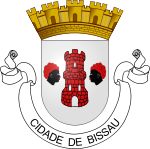Bissau
| Bissau |
|
|

Flag |

Coat of arms |
|
|
Location of Bissau in Guinea-Bissau
|
| Coordinates: |
| Country |
 Guinea-Bissau Guinea-Bissau |
| Region |
Bissau Autonomous Sector |
| Region |
|
| Area |
| - Total |
29.7 sq mi (77 km2) |
| Population (2007) |
| - Total |
407,424 est. |
| - Density |
13,704.1/sq mi (5,291.2/km2) |
Bissau is the capital city of Guinea-Bissau. The city's borders are conterminous with the Bissau Autonomous Sector. In 2007, the city had an estimated population of 407,424 according to the Instituto Nacional de Estatística e Censos.[1] The city which is located on the Geba River estuary, off the Atlantic Ocean, is the country's largest city, major port, administrative and military center.
History and landmarks
The city was founded in 1687 by Portugal as a fortified port and trading center. In 1942 it became the capital of Portuguese Guinea. After the declaration of independence by the anti-colonial guerrillas of PAIGC, in 1973, the capital of the de facto independent territories was declared to be Madina do Boe, but Bissau remained as the capital of the Portuguese-occupied regions, and the de jure capital of the entire Portuguese Guinea. When Portugal recognized the independence of Guinea-Bissau and pulled out in 1974 due to the military coup of April 25 in Lisbon, the two territories merged and Bissau became the capital of the new independent state.
The city is known for its annual carnival. Other attractions include the Portuguese-built Fortaleza de São José da Amura barracks from the 1700s, containing Amílcar Cabral's mausoleum, the Pidjiguiti Memorial to the dockers killed in the Bissau Dockers' Strike on August 3, 1959, the Guinea-Bissau National Arts Institute, Bissau New Stadium and local beaches. Many buildings in the city were ruined during the Guinea-Bissau Civil War (1998 - 1999), including the Guinea-Bissau Presidential Palace and the Bissau French Cultural Centre (now rebuilt), and the city centre is still underdeveloped.
Geography

View of Bissau from Rio Gêba
Bissau is located at 11°52' North, 15°36' West (11.86667, -15.60) [1], on the Geba River estuary, off the Atlantic Ocean.
Demographics
The last time an official census was held in the country, in 1991, the city/region had a population of 195,389. However, by 2007, the city had an estimated population of 407,424 according to the Instituto Nacional de Estatística e Censos.[1]
Economy
Bissau is the country's largest city, major port, educational, administrative and military center. Peanuts, hardwoods, copra, palm oil, and rubber are the chief products. The airport that serves Bissau is Osvaldo Vieira International Airport. Poverty and lack of development is widespread.
Sister cities
References
- ↑ 1.0 1.1 Instituto Nacional de Estatística e Censos
- Richard Andrew Lobban, Jr. and Peter Karibe Mendy, Historical Dictionary of the Republic of Guinea-Bissau, 3rd ed. (Scarecrow Press, 1997, ISBN 0-8108-3226-7) pp. 91–96
|
Regions of Guinea-Bissau |
|
Bafatá · Biombo · Bissau (autonomous sector) · Bolama · Cacheu · Gabú · Oio · Quinara · Tombali
|
 |
|
|
Capitals of Africa |
|
| |
Abuja, Nigeria
Accra, Ghana
Addis Ababa, Ethiopia
Algiers, Algeria
Antananarivo, Madagascar
Asmara, Eritrea
Bamako, Mali
Bangui, Central African Republic
Banjul, Gambia
Bissau, Guinea-Bissau
Bloemfontein, South Africa1
Brazzaville, Rep. Congo
Bujumbura, Burundi
Cairo, Egypt
Cape Town, South Africa2
|
Conakry, Guinea
Dakar, Senegal
Djibouti, Djibouti
Dodoma, Tanzania
Freetown, Sierra Leone
Gaborone, Botswana
Harare, Zimbabwe
Hargeisa, Somaliland4
Jamestown, Saint Helena
Kampala, Uganda
Khartoum, Sudan
Kigali, Rwanda
Kinshasa, DR Congo
Libreville, Gabon
Lilongwe, Malawi
|
Lobamba, Swaziland2
Lomé, Togo
Luanda, Angola
Lusaka, Zambia
Malabo, Equatorial Guinea
Mamoudzou, Mayotte
Maputo, Mozambique
Maseru, Lesotho
Mbabane, Swaziland3
Mogadishu, Somalia
Monrovia, Liberia
Moroni, Comoros
Nairobi, Kenya
N'Djamena, Chad
Niamey, Niger
|
Nouakchott, Mauritania
Ouagadougou, Burkina Faso
Port Louis, Mauritius
Porto-Novo, Benin
Praia, Cape Verde
Pretoria, South Africa3
Rabat, Morocco
Saint-Denis, Réunion
São Tomé, São Tomé and Príncipe
Tripoli, Libya
Tunis, Tunisia
Victoria, Seychelles
Windhoek, Namibia
Yaoundé, Cameroon
Yamoussoukro, Côte d'Ivoire
|
|
|
| 1 Judicial. 2 Parliamentary. 3 Executive. 4 an unrecognized or partially recognized state |
|
|
Portuguese Empire |
|
North Africa
|
15th century
1415–1640 Ceuta
1458–1550 Alcácer Ceguer (El Qsar es Seghir)
1471–1550 Arzila (Asilah)
1471–1662 Tangier
1485–1550 Mazagan (El Jadida)
1487– middle 16th century Ouadane
1488–1541 Safim (Safi)
1489 Graciosa
|
16th century
1505–1769 Santa Cruz do Cabo de Gué (Agadir)
1506–1525 Mogador (Essaouira)
1506–1525 Aguz (Souira Guedima)
1506–1769 Mazagan (El Jadida)
1513–1541 Azamor (Azemmour)
1515 Sao Joao da Mamora (Mehdya)
1577–1589 Arzila (Asilah)
|

|
Southwest Asia
|
16th century
1506–1615 Gamru (Bandar-Abbas)
1507–1643 Sohar
1515–1622 Hormuz (Ormus)
1515–1648 Quriyat
1515–? Qalhat
1515–1650 Muscat
1515?–? Barka
1515–1633? Julfar (Ras al-Khaimah)
1521–1602 Bahrain (Muharraq and Manama)
1521–1529? Qatif
1521?–1551? Tarut Island
1550–1551 Qatif
1588–1648 Matrah
|
17th century
1620–? Khor Fakkan
1621?–? As Sib
1621–1622 Qeshm
1623–? Khasab
1623–? Libedia
1624–? Kalba
1624–? Madha
1624–1648 Dibba Al-Hisn
1624?–? Bandar-e Kong
|
|
East Asia and Oceania
|
16th century
1511–1641 Portuguese Malacca
1512–1621 Moluccas (Maluku Islands)
1522–1575 Ternate
1576–1605 Ambon
1578–1650 Tidore
1512–1665 Makassar
1553–1999 Macau
1533–1545 Ningbo
1571–1639 Decima (Dejima, Nagasaki)
|
17th century
1642–1975 Portuguese Timor (East Timor)1
19th century
Macau
1864–1999 Coloane
1849–1999 Portas do Cerco
1851–1999 Taipa
1890–1999 Ilha Verde
20th century
Macau
1938–1941 Lapa and Montanha (Hengqin)
|
|
1 1975 is the date of East Timor's Declaration of Independence and subsequent invasion by Indonesia. In 2002, the independence of East Timor was recognized by Portugal and the rest of the world.
|
North America and the North Atlantic Ocean
Central and South America
|
16th century
1500–1822 Brazil
1536–1620 Barbados
|
17th century
1680–1777 Nova Colônia do Sacramento
19th century
1808–1822 Cisplatina (Uruguay)
|
Portuguese colonization of the Americas
Theory of Portuguese discovery of Australia
|
|




